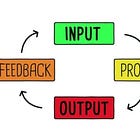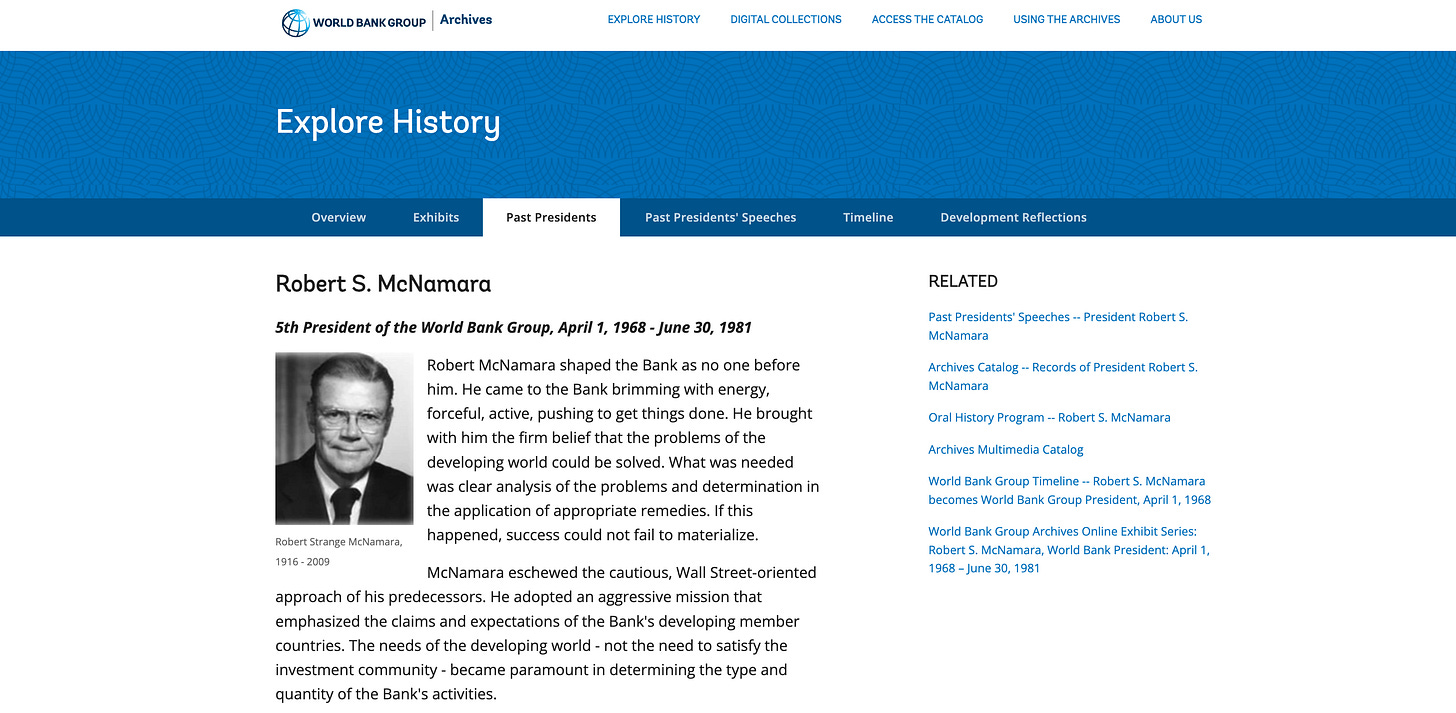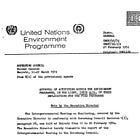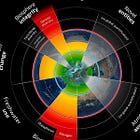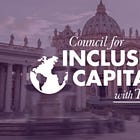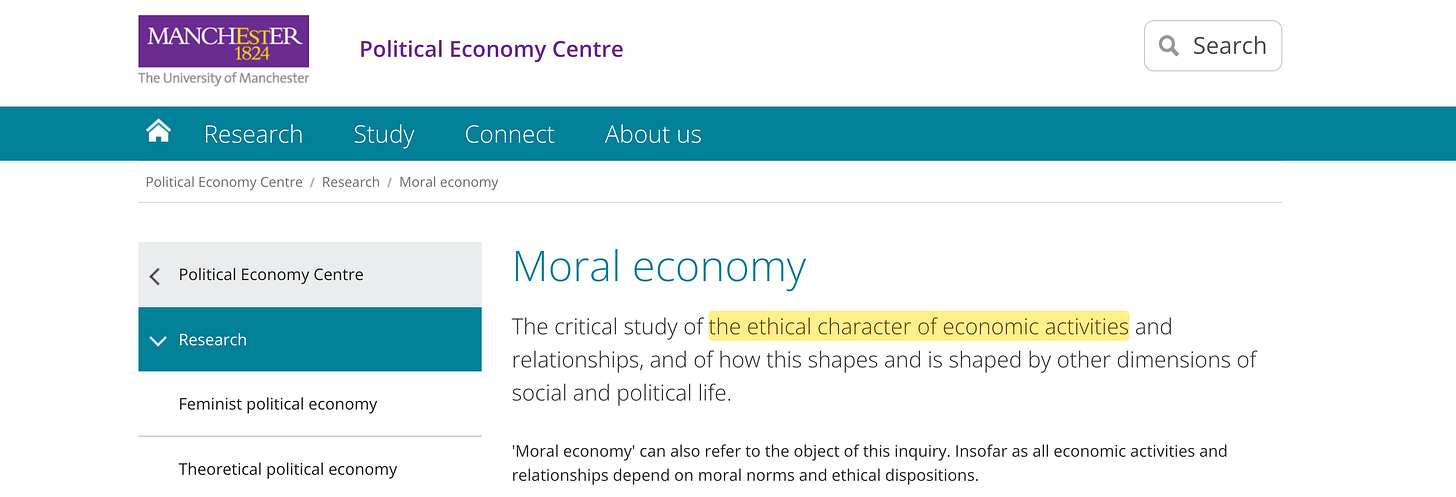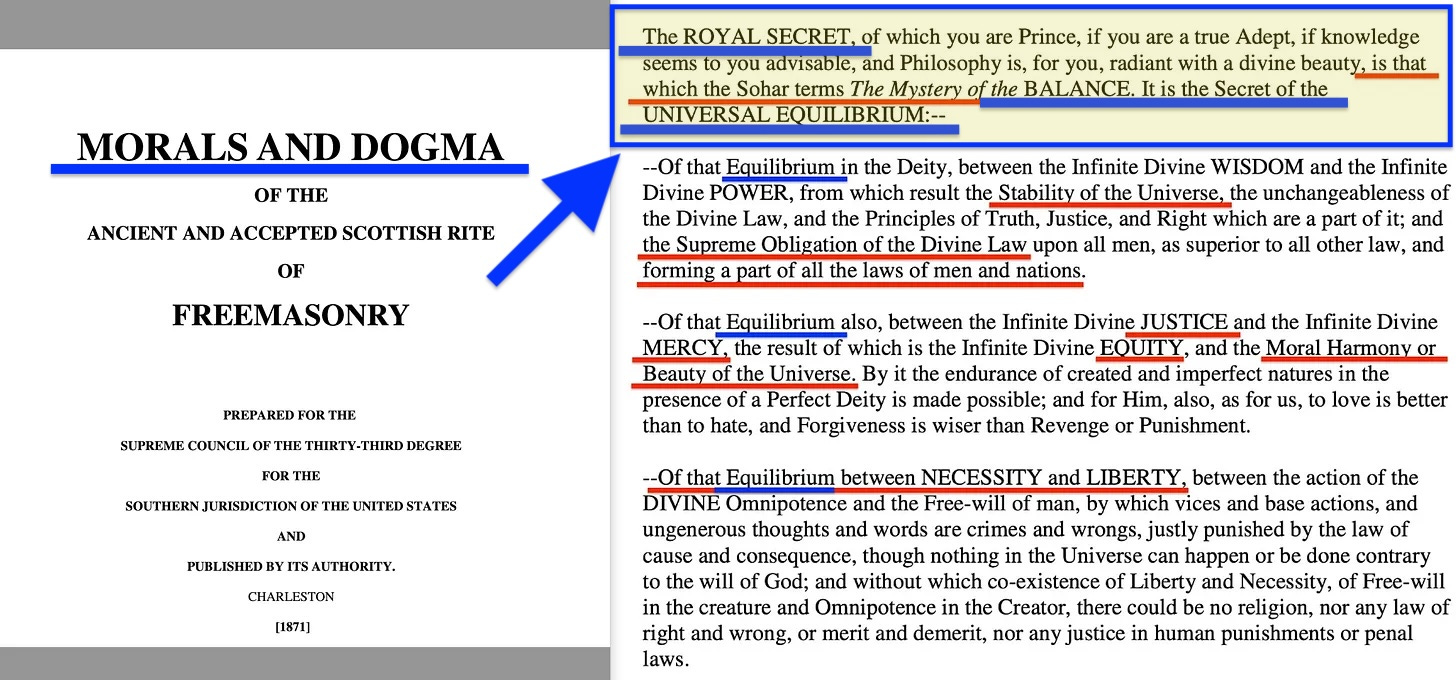History, Restated
The Genesis of Indicator Colonialism
A quiet revolution took shape in the early 1960s. In a Pentagon meeting room, Secretary of Defense Robert McNamara and his comptroller Charles Hitch introduced a new management system that would quietly but permanently transform how societies are governed. The Planning, Programming, and Budgeting System1 (PPBS) insisted that every governmental aspiration be reduced to numbers: defined inputs and outputs, clear objectives, cost projections, and performance budgets.
Few at the time realised the true gravity of the shift. This wasn’t just administrative reform — it was the beginning of a new paradigm in which politics would be reframed as management, and values as variables.
PPBS was not a mere bureaucratic reform; it was a philosophical coup — restructuring governance into a perpetual loop of:
Planning (defining measurable strategic objectives)
Programming (designing costed projects proportional to those objectives)
Budgeting (funneling resources to prioritised programs)
This was the birth of a new managerial priesthood: systems analysts with the authority to translate values, claims of justice, and societal aspirations into input-output matrices. Once optimised under constraints, these models could remove human judgment and political conflict from the equation. It was, in essence, an early step toward the dehumanisation of society itself — granting technocrats powers outside political reach, without public debate or democratic consent.
Under this model, every public aim — whether military, social, or economic — was to be rendered calculable, comparable, and auditable. PPBS did not simply reform management through input-output analysis; it reimagined democracy and justice as technical problems to be solved by indicator-driven optimisation. Politics was no longer a space for contestation — it became a branch of management science.
When Lyndon Johnson announced his Great Society in 19652, few realised it quietly signaled the full institutionalisation of PPBS across government. The War on Poverty required measurable indicators — quantified distributions of deprivation — and thus demanded a new statistical infrastructure to support its aims. A flurry of Executive Orders soon followed, mandating data collection to supply inputs for the very indicators designed to eliminate poverty.
But the logic did not stop at social policy. Once PPBS was mandated across federal agencies, it quickly spread to every domain: health, water, air, land, and sea. A wave of Executive Orders and Acts followed, each calling for the protection of systems — ecological, biological, infrastructural — recast as programmable domains.
By 1966, the Spaceship Earth concept entered public discourse. Though Arthur C. Clarke discussed it as early as 19603, it was Buckminster Fuller who gave it cultural momentum4. Barbara Ward adopted it in the context of environmental stewardship5; Kenneth Boulding applied it to economics6, portraying the Earth as a closed-loop system of circulating matter and energy. This closed-system framing would later inspire the concept of the Circular Economy7 — where efficiency, balance, and sustainable throughput became moral imperatives.
PPBS metastasised rapidly beyond the Department of Defense. When Robert McNamara became President of the World Bank in 19688, he exported its cybernetic logic directly into development finance. Borrower nations were compelled to produce Country Program Papers9 (CPPs): long-term, quantified strategies filled with tables, indicators, and performance forecasts — as if entire societies could be governed like Pentagon logistics. Every hill, every harvest, every health clinic became a line item, each tagged with measurable targets. Democratic deliberation was displaced by technocratic planning, while societal goals — economic growth, poverty reduction, health, education — were collapsed into spreadsheeted checklists, enforced by loan conditionality.
This logic soon saturated the expanding web of multilateral agencies. The United Nations Development Programme (UNDP), WHO, UNESCO, and others eagerly embraced the doctrine. By the 1970s, these bodies mandated results-based management10, requiring that every ambition — from literacy rates to infant mortality — be expressed as deliverables, indicators, and deadlines. National governments followed suit. Johnson’s Great Society had already institutionalised planning cycles and performance metrics to ‘eradicate’ poverty, manage health, and regulate cities. Now, everything became a Key Performance Indicator11: air quality, water purity, job training, nutrition. Complex human problems were reduced to auditable checkboxes.
No domain was too sacred to escape the new procedures. Air, water, health, nutrition, even education — once articulated in the language of rights and responsibilities — were forcibly recoded as technical problems to be monitored, benchmarked, and ‘solved’ by surveillance data indicators, ultimately routed through forward predicting computers, with the Club of Rome’s World3 model12 being an early such influence.
What happens when justice becomes an equation? When the success of public policy is judged by numbers alone? The early advocates may not have said so explicitly, but the outcome was unmistakable: values were subordinated to efficiency, and political conflicts — over resources, rights, redistribution — were recast as optimisation problems. Systems analysts came to believe they could allocate goods more fairly and rationally than through public debate. But by filtering every aspiration through indicator data, the most human of concerns were entirely dehumanised.
The emergence of the Spaceship Earth worldview in the 1960s provided the ideological foundation for the expanding apparatus of cybernetic governance. Kenneth Boulding argued that humanity now lived aboard a single, closed, finite vessel — hurtling through space and demanding maximum efficiency, coordination, and scientific control of its resources. In his influential 1966 essay, Boulding reframed the planet as a bounded system requiring total planning — not through politics, but through the guidance of scientists and systems managers. And this metaphor quickly captured imagination: the Earth could — and should — be governed as one integrated system.
By 1968, this vision had been institutionalised. UNESCO’s landmark Biosphere Conference in Paris redefined environmental preservation as a planetary engineering problem to be solved not by democratic deliberation, but by optimisation through scientific councils and transnational oversight bodies. Environmental questions were no longer framed as moral or political concerns; they became technical puzzles. Committees like SCOPE (the Scientific Committee on Problems of the Environment) emerged to legitimise this new paradigm, offering early solutions for the measuring, modelling, and ultimately managing of the entire biosphere.
Under this ethos, policy expanded beyond traditional social programmes to include the atmosphere, oceans, and even the inner workings of the human body. If humanity shared one closed ecological system, then every component — every emission, every metric, every risk — had to be monitored, measured, and managed. This belief justified the construction of vast planetary sensing infrastructures. After the 1972 UN Conference in Stockholm13, the United Nations Environment Programme launched the Global Environment Monitoring System (GEMS): a real-time data network spanning tens of thousands of stations to track weather, pollution, and ecological conditions. The ambition was sweeping — to build a collective nervous system for Earth, enabling humanity to steer its own evolution with cybernetic precision.
Meanwhile, satellites, sensors, and simulation models were cast as the essential instruments of planetary management. Also in 1972, the East and West combined established the International Institute for Applied Systems Analysis14 (IIASA) — a Cold War initiative to address ‘problems too large or complex for any one nation’, from climate change to resource scarcity, through advanced modelling and systems science. The resulting cybernetic infrastructure — feedback loops, databanks, remote sensing — was not merely meant to observe the planet, but to regulate it in real time.
By the late 1970s, environmental governance had begun to mirror military command structures. At the First World Climate Conference in 1979, anthropogenic climate change was formally recognised as a global threat requiring unified response. This logic culminated at the 1992 Rio Earth Summit, where environmental regulation was reframed as economic architecture: carbon emissions via Combating Global Warming were to be priced and traded under the Kyoto Protocol; biodiversity was assigned a market value. In each case, the living world was converted into a matrix of indicators, targets, and financial incentives — a planetary control regime governed not by citizens, but by technocrats and their unchallengeable simulations.
While Earth’s systems were being rationalised through indicators and models, another revolution was unfolding overhead. In the late 1950s and early 1960s, the first orbital eyes opened a new dimension of control. In 1960, the United States launched CORONA15, the world’s first imaging reconnaissance satellite — quietly inaugurating an era in which entire continents could be photographed from space, without a single boot on the ground. Though the programme remained classified, its implications were profound: the planet could now be monitored continuously, comprehensively, and remotely. Over the following decade, CORONA and its successors wove an invisible net of surveillance, capturing thousands of images that mapped the Earth with unprecedented granularity16.
At the same time, the United Nations was laying the diplomatic foundations for this new orbital order. In 1959, spurred by the launch of Sputnik and the looming spectre of space weaponisation, it established the Committee on the Peaceful Uses of Outer Space (COPUOS)17. Its aim was twofold: to prevent military escalation in orbit, and to legitimise satellite technologies for ‘the benefit of all mankind’. The 1967 Outer Space Treaty18, drafted under COPUOS, banned nuclear weapons in space but made no secret of its tacit bargain: satellites could only be used peacefully — which was to say, they would be used. From the outset, surveillance and diplomacy advanced hand in hand. As spy satellites monitored adversaries, they also harvested data on weather, crops, navigation, and emissions. In 1972, the Cold War rivals signed the US–USSR Environmental Cooperation Agreement, calling for the joint application of contemporary scientific, technical, and managerial achievements to solve planetary problems — and to write related common policy.
By the end of the 20th century, the world had grown accustomed to being visible. Satellite imagery and remote sensors had become routine instruments of governance. The UN’s mandate for the ‘peaceful uses’ of space provided cover for global data collection, so long as it was framed as benign. By the 1980s, satellite feeds were fuelling environmental research and development planning; by the 2000s, they were central to climate modelling, emissions tracking, and global risk assessments. In effect, the sky itself had been integrated into the cybernetic plan — all, allegedly, for our protection.
Back on the ground, public health followed a parallel trajectory. By the 1970s, health policy was no longer defined simply as access to medical care, but as a complex system of quantifiable relationships between biology, environment, and behaviour. Canada’s influential Lalonde Report19 (1974) inaugurated the era of ‘health determinants’, broadening the field to include lifestyle and environmental variables as drivers of health outcomes. The World Health Organisation quickly adopted this systems-based framing. In 1978, the Alma-Ata Declaration20 proclaimed ‘Health for All’ by the year 2000 — not as a moral aspiration, but as a programme of measurable, time-bound targets, anchored in standardised primary care and global monitoring systems. The logic deepened in 1986 with the Ottawa Charter on Health Promotion21, which laid out a set of prerequisites for well-being — peace, income, shelter, education, social justice — each implicitly recast as policy levers and indicators to be managed through intersectoral coordination.
By the turn of the millennium, this fusion of managerial ambition and biopolitical strategy had matured into a sweeping surveillance infrastructure. Health was no longer merely a national priority — it had become a global security concern. Early-warning systems, vaccine stockpiles, and genomic surveillance grids proliferated. The crises of the 21st century accelerated this transformation. In the wake of 9/11, laws such as the U.S. PATRIOT Act and the Bioterrorism Act vastly expanded the scope of permissible health and biometric data collection under the banner of national security. Pandemics — H5N1 (1997), SARS (2003), H1N1 (2009), COVID-19 (2020) — served as catalytic events, while authorities deployed digital contact-tracing apps, real-time symptom tracking, and centralised bio-monitoring tools, often justified as temporary public health necessities. In practice, these tools continuously extended the system’s reach into everyday life — embedding alleged risk management deep into the fabric of society.
Today, the Pandemic Treaty (2025) seeks to codify this transformation into international law. Under its provisions, global biosurveillance will become legally enforceable. Illness, immunity, and even individual genetic profiles can be folded into a permanent, centralised system of planetary and holistic global health security. Like the environment and the economy before it, health has become another factor absorbed into the cybernetic matrix.
The language has shifted accordingly. The body is no longer sacred or private — it is a source of behavioural inputs and biological outputs to be measured, nudged, and controlled. Personal well-being has become a logistical variable: managed by algorithms, regulated by access systems, and justified through risk scores. In the name of global safety, the final frontier of control has become the body itself.
In the 2010s, a new doctrine emerged to fuse algorithmic planning with capital allocation: Inclusive Capitalism. Promoted by a sprawling network of corporate, philanthropic, and regulatory elites, it branded itself as a moral upgrade — ‘aligning business with the common good’ and ‘measuring stakeholder value’. In practice, it extended the logic of cybernetic governance into the boardroom. ESG (Environmental, Social, and Governance) metrics, HDI (Human Development Index) indicators, Aichi biodiversity targets, and SDG (Sustainable Development Goal) indicators were parsed into global dashboards, transforming justice, equity, and sustainability into standardised reporting categories. Companies now quantify stakeholder interests — not by redistributing power or altering structures, but by shuffling about diversity quotas, carbon disclosures, and compliance forms.
On the surface, this may appear as progress. After all, shouldn’t corporations be held accountable for social and environmental impact? But beneath the veneer lies a sleight of hand. Inclusion becomes inclusion-in-the-numbers. A firm may tout a committee on racial equity or a LEED-certified building22, yet ownership, control, and extractive operations remain untouched. Justice becomes a performance metric, sustainability a branding strategy, and ‘shared value’ and ‘sustainable growth’ are ethical stamps of approval — and very little else.
The logic of metric-based quasi-salvation found unlikely echoes in the religious sphere. Laudato Si and Laudate Deum23 promoted the whole ensemble — including the alleged Climate Crisis — cooperating with the vision of the moral economy and thus Inclusive Capitalism, while Prosperity Gospel24 mapped spiritual virtue directly onto material success. Wealth, health, and even political stability were reinterpreted as signs of divine favour, awarded to those who mastered the correct ‘formulas’ and ‘positive confessions’. Faith was reduced to metrics, blessings as bullet points, prayer as input, and prosperity as output. In this framework, poverty was not per se a social or structural condition, but an individual failure relating to belief.
This theology interestingly mirrored the logic of corporate ESG frameworks and stakeholder capitalism almost perfectly, as both are governed by hidden ledgers and formulas. Obey the indicators, tick the boxes, and the algorithm — divine or financial — will reward you. If injustice persists, it is not due to structural imbalance but because someone — likely you — failed to perform correctly. Inequality is recast as a failure of technique or attitude, not of power — never of power. In this way, prosperity theology sanctifies the very logic of cybernetic governance, where compliance is considered virtue, and success righteousness.
But the prosperity gospel was only one side of the coin. Its inverse emerged as liberation theology25 — especially in Latin America — which demanded a preferential option for the poor and a confrontation with structural injustice. Where prosperity theology individualised blame and equated wealth with virtue, liberation theology collectivised suffering and called for systemic transformation. One said poverty was a failure of belief; the other said it was a consequence of power.
They appear opposed — one exalting personal accumulation, the other calling for material redistribution. But together, they form a dialectic, reframing moral questions in material terms. Both accepted that justice, salvation, and worth could be understood — and ultimately delivered — through the management of resources. One routed this through markets, the other through planning. But money remained the medium, and finance was the structure that contained both.
And once faith was folded into the financial, both paths led to the same destination, met by indicators, outcomes, and returns on ‘social investment’. Development goals replaced moral ends, and progress was tracked through metrics — while righteousness became a central question of the moral economy26.
But if inclusive capitalism and the prosperity gospel represent the polite face of metric obsession, then technocracy is its naked form. The intellectual roots of today’s programmable governance systems stretch back to the 1930s, when Technocracy, Inc27. proposed the total replacement of money, politics, and moral deliberation with engineered control. In their vision, citizens would receive energy certificates28 based on their share of national thermodynamic output. These certificates, calibrated to energy expenditure, would determine exactly what one could consume, where one could travel, and how one should work. Society would be governed not by law or consent, but by expert-calculated necessity — an operating system for humanity based on inputs, outputs, and tracked behaviour.
The technocrats openly envisioned a world in which even the right to save would disappear. Nothing would be voluntary; every action would be preallocated by equations. This chilling blueprint finds clear echoes today. Carbon credit markets reduce the right to emit into a tradable certificate. Central bank digital currencies (CBDCs) raise the prospect of programmable money — tokens that can be earmarked for specific uses or set to automatically expire. Social credit systems push this logic further still, ranking individuals by algorithmic compliance and restricting access accordingly. In each case, the citizen becomes a node in an engineering model — governed not by politics, but by parameters.
Under such systems, metrics become law, and law becomes automatable. The danger of technocracy is not merely its cold efficiency — it is its absolute disregard for human subjectivity. It promises to eliminate waste, but only through the elimination of related freedom. It makes what people ought to do more efficient, but leaves no room for dissent, imagination, or unpredictable will.
All of the above might sound abstract — but it is in fact already happening. The cybernetic empire is not theoretical; it is being built phase by phase, as technical, financial, ethical, and political systems converge into a single programmable architecture. The timeline is not speculative.
2020–2025: Deployment (Already Active)
The COVID-19 pandemic marked a critical inflection point. Under the guise of public health, governments rapidly deployed digital IDs claiming to be vaccine passports, contact-tracing surveillance apps, and biometric checkpoints. Central banks, meanwhile, moved quietly to lay the groundwork for programmable currencies. Initiatives such as the BIS’s mBridge, the ECB’s digital euro, and Switzerland’s Helvetia tested blockchain-enabled payment systems capable of embedding policy logic — such as carbon taxes or spending limits — if not directly into money itself, then into the digital wallets in which CBDCs are stored. Simultaneously, mass AI adoption accelerated across media, business, and government, while regulatory frameworks like the EU’s AI Act and global sustainability reporting standards began encoding how data must be measured, interpreted, and disclosed.
2025–2030: Integration
This next phase brings convergence. Pilot programmes are already emerging that tie digital wallets to an individual’s ‘carbon budget’ or social compliance score — determining what can be bought, where one can travel, and which subsidies or penalties apply. ESG and SDG frameworks are being fused into computational ethics29, driving a shift toward automated decision-making in hiring, policing, housing, and healthcare. AI compliance laws will require ‘ethical systems’ in every sector, increasingly replacing human judgment with moral calculations computed by software. Employment is being restructured as automation displaces intellectual labour, with human roles increasingly defined by data productivity, with OECD already now tracking human capability relative to AI30. Meanwhile, crises — climatic, epidemiological, financial — are leveraged to tighten control: curfews, carbon quotas, IoT surveillance, real-time monitoring and digital twins all become justifiable under the rubric of safety and sustainability. Gradually, a universal moral grammar is emerging — standardising eligibility for aid, credit, education, or movement according to behavioural conformity with global indicators.
2030–2035: Stabilisation
By this stage, the architecture begins to self-correct. Digital twins run constant real-time feedback loops, adjusting policy and nudging populations toward algorithmically defined equilibrium. Most labour is either automated or permissioned through data profiles. Rather than applying for jobs, citizens may be required to qualify for roles based on compliance history, consumption records, or ethical scores. Democratic governance becomes increasingly impotent — not because power disappears, but because decisions are reached through technocratic deliberation. Ethical discourse itself may dissolve into procedural compliance, as populations learn — by design or coercion — that every social problem has a single, measurable ‘right’ answer. Dissent, where it persists, appears first as an anomaly in the data — and is corrected accordingly, first through nudging escalated through penalties and invasive procedures such as lockdowns, with rights to access your own money eventually taken away, as first trialled by Trudeau in Canada.
At this point, we enter what might be called a regime of computational ethics: a universal moral economy in which every right, duty, and entitlement is dictated algorithmically. Each action becomes either a token to be spent or a quota to be respected. The question is no longer whether such a system will exist, but whether it will be hailed as the triumph of fairness — or become the end of freedom.
Looking back, the arc is unmistakable: what began in a Pentagon systems analysis office has quietly extended into every sphere of life. The logic of efficiency — originally designed for defence budgets — now governs policy, finance, health, education, and even conscience, with PPBS and later equivalents having gone from strength to strength. Whether it goes by the name of stakeholder capitalism, KPI-driven governance, sustainable development, or simply ‘progress’, the effect is the same: a single, integrated system of total control.
We stand on the threshold of a regime first dreamed generations ago — a world in which every moral, political, and existential claim must first be rendered as an indicator, a metric, a key performance input.
This system does not impose itself all at once, because that would increase the risk of being discovered. Yet, Trump became a living avatar of prosperity theology, preaching faith-as-performance and wealth-as-blessing, while governing through a lens of metrics and market affirmation. Biden and Harris, meanwhile, channel the aesthetic of liberation theology — promising structural compassion and equity — yet ultimately feeding these aspirations into the same technocratic machine, where justice is measured in policy deliverables and inclusive growth targets. And then there is Elon Musk, who represents a third frontier: the apolitical engineer-king, resurrecting the technocratic ideal of Technocracy Inc — a world where authority derives from equations. His meme-driven embrace of DOGE is more than trolling — it hints at a deeper ambition: to automate trust itself, shifting the authority to audit, spend, and program value away from governments and toward a world, eventually completely driven by machines, justified by computational ethics and — Inclusive Capitalism.
The crucial point is this: inclusion, prosperity, sustainability — these are but mere moral alibis. Stamp a digital certificate, publish a compliance report, and the system claims moral legitimacy. But the real questions — Who owns the resources? Who writes the algorithm? Who decides what counts as good? — are quietly deferred to engineers, economists, and private platforms — technocrats, in short, resting entirely outside of democratic capacity. The very language of justice is written in computer software — and no-one was ever allowed to vote for this trajectory, nor even given a chance to appropriate discuss it — precisely because it would be rejected. But this outcome cannot be accepted by the Fabian Society, the central banks, the Royal Institute of International Affairs and fellow think tanks. Because they — above all — know what’s best, not only for you and I, but the planet as a whole. As they take this spiritual call of planetary stewardship so serious, that they have dedicated decades of their lives in a deliberate attempt to conceal this from the very people they claim to represent.
We stand at a crossroads. On one path lies full submission to a world in which lives, rights, and values are determined by cybernetic feedback loops and tokenised incentives — with every deviation flagged, and recorded… forever. And where repeated crises serve as opportunities — not to rethink the system, but to tighten it.
On the other path lies the messy, contested, human alternative: politics by debate, rights by declaration, and justice as a lived experience that cannot be programmed. The only real resistance to the cybernetic regime — no matter how it dresses itself, whether as equity, efficiency, or empathy — is to refuse the reduction of the human to an indicator datapoint, and the world to a dashboard.
This is the defining choice of our era. Not between liberation theology on the left and prosperity gospel on the right — both of which ultimately relate to a tug-of-war in which the only winner is the technocratic mediator. No, it’s a battle between analogue and digital, between control and meaning. Between a predicted future addressed ‘ethically’, and a future open to individualism and imagination.
Or perhaps you prefer to frame is as a battle between light and shadow, or the material and spiritual. Either way, we certainly don’t need a level 33 freemason to mediate the struggle31 on our behalf — and even less so, a machine determining the situation through computational ethics.







